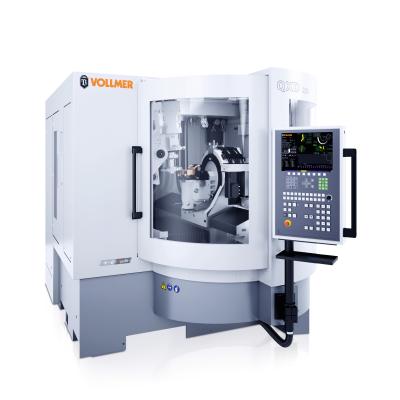
The Vollmer eroding machine QXD 250 makes it possible for tool manufacturers to process more than 30 percent more PCD cutters in the same amount of time as has been the case up to now. This milestone in production is made possible by the generator technology Vpulse EDM, which sets the eroding beat at the heart of the QXD 250. Depending on the demands, the Vpulse EDM can increase the speed of the tool production or increase the surface fineness. The Vpulse EDM achieves these advances when processing PCD surfaces by using individually cycled eroding impulses. This corresponds to two-fold improvement and more in comparison to the eroding technology available until now.
The QXD 250 gives greater flexibility and opens up a wide range of new possibilities for PCD tool manufacturers when processing PCD cutters, allowing manufacturers to react in a targeted way to the demands of their customers and markets. The Vollmer universal machine also offers a simultaneous track interpolation in six CNC controlled axes. As a result of the increased tool track distance and swivel range, PCD tools with diameters of 320mm and lengths of 250mm can be precisely processed. In one single clamping fixture, the QXD 250 measures, grinds, erodes and polishes diamond tools in only one combined process. The Vollmer automation technology allows 24-hour production without the need for an operator to be present, during which the loading and emptying of the workpiece reservoir can take place simultaneously by automatic operation. The integrated tool changer for up to six eroding, grinding or polishing discs makes the processing of different work piece variants possible.
Contact Details
Related Glossary Terms
- computer numerical control ( CNC)
computer numerical control ( CNC)
Microprocessor-based controller dedicated to a machine tool that permits the creation or modification of parts. Programmed numerical control activates the machine’s servos and spindle drives and controls the various machining operations. See DNC, direct numerical control; NC, numerical control.
- electrical-discharge machining ( EDM)
electrical-discharge machining ( EDM)
Process that vaporizes conductive materials by controlled application of pulsed electrical current that flows between a workpiece and electrode (tool) in a dielectric fluid. Permits machining shapes to tight accuracies without the internal stresses conventional machining often generates. Useful in diemaking.
- fixture
fixture
Device, often made in-house, that holds a specific workpiece. See jig; modular fixturing.
- grinding
grinding
Machining operation in which material is removed from the workpiece by a powered abrasive wheel, stone, belt, paste, sheet, compound, slurry, etc. Takes various forms: surface grinding (creates flat and/or squared surfaces); cylindrical grinding (for external cylindrical and tapered shapes, fillets, undercuts, etc.); centerless grinding; chamfering; thread and form grinding; tool and cutter grinding; offhand grinding; lapping and polishing (grinding with extremely fine grits to create ultrasmooth surfaces); honing; and disc grinding.
- interpolation
interpolation
Process of generating a sufficient number of positioning commands for the servomotors driving the machine tool so the path of the tool closely approximates the ideal path. See CNC, computer numerical control; NC, numerical control.
- polishing
polishing
Abrasive process that improves surface finish and blends contours. Abrasive particles attached to a flexible backing abrade the workpiece.
- polycrystalline diamond ( PCD)
polycrystalline diamond ( PCD)
Cutting tool material consisting of natural or synthetic diamond crystals bonded together under high pressure at elevated temperatures. PCD is available as a tip brazed to a carbide insert carrier. Used for machining nonferrous alloys and nonmetallic materials at high cutting speeds.

